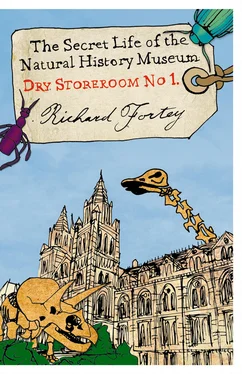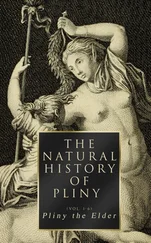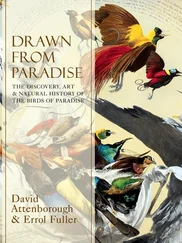Linnaeus’ tercentenary was in 2007. As part of the celebrations I was asked to reply to a speech given at the Linnean Society of London by His Imperial Majesty Emperor Akihito of Japan. Thanks to Linnaeus, His Majesty was able to talk to his fellow ichthyologists about his favorite organisms, small fishes called gobies. I was told that the trees in the Imperial Garden are labelled with their scientific names. We all understood one another, and everyone smiled. Linnaeus worked in his maturity in the charming and ancient city of Uppsala; his system triumphed because of its utility and comprehensiveness. He developed his ideas in plant classification as a young man during travels to Lappland – then a daring undertaking. A quirky portrait of him dressed in Lappish robes was actually painted in Amsterdam a few years later, but it does seem that, like Darwin on The Beagle , a youthful adventure set him on the course to greatness. His classification of plants was based on such features as counting the number of stamens – it was a sexual system. Some young ladies were forbidden to study it because it might bring a blush to their delicate cheeks. Linnaeus’ mission to classify knew no bounds: he moved from plants to animals. Deus crevait, Linnaeus disposuit (God created, Linnaeus organized) served as his motto. He distributed his binomials far and wide. The Botanical Garden he laid out in Uppsala, with neat beds arranged according to his system, is still in good order. It ought to be one of the holy places for scientists to visit. Even if the simple sexual system has now been superseded the legacy of the names lives on. Linnaeus’ higher and more inclusive levels of organizing organisms into Order and Class and Kingdom are also still used as part of the hierarchy of the system. The labels on the cupboards that I passed in my peripatetic passage around the Natural History Museum were mostly family names, and the family originated as a unit of classification slightly later. *Inside a given cupboard the curator might have placed a number of species belonging to several genera, all embraced by the family whose name is on the door. It is, if you like, a sophisticated filing system, and if you have millions of specimens the necessity of a filing system that works is patently obvious. I will leave until later in this chapter the question of what the filing system actually means in terms of evolution and ancestry, since Linnaeus lived and worked in a pre-Darwinian world, although I should say that like all taxonomists he used the features of the plant or animal concerned as the basis for his classification. The convention of using Latin and Greek for names was easy work for the early taxonomists. Most of them had been educated in the classics, and they knew their way around mythology and literature. Quite soon a whole dictionary of gods, goddesses, nymphs and satyrs had been recruited to label the natural world, mostly as generic names. Daphne is a flowering shrub, Daphnia is a water flea; Daphne herself was a nymph pursued by Apollo, and changed into a bay tree, as always seemed to be happening in those days. The bay tree itself is Laurus nobilis , ‘noble’ because the aromatic leaves were used to crown the brows of heroes.
Like nobilis , species names often were, and still are, epithets describing some salient feature of the animal or plant in question. A very beautiful plant might be the species magnifica , a very ugly one the species horrida . The specific names can be much more complicated, produced by splicing several Latin words together, so that a species with bright green leaves might be viridifolia , or one with leaves resembling the skin of a crocodile crocodilifolia ; this complexity is fortunate, since a very large number of names are needed to accommodate all the beetles. It is necessary for the describer to have at least some knowledge of the classical languages because of the rule that genera have gender – masculine, feminine or neuter – and the species name should therefore agree in gender with that of its genus. The suffix on a genus - us is masculine and requires a matching - us on the species. The suffix - a is feminine, so that a commonly cultivated shrub originating from South America is Fuchsia magellanica and not Fuchsia magellanicus ; - um is a neutral ending. Incidentally, Fuchsia is named after a famous herbalist, Leonhard Fuchs, who illustrated plants most decoratively two centuries before Linnaeus, and although Fuchs was evidently male, the genus named for him is female. This paradoxical practice is very common in botany: the well-known names Forsythia , Buddleia and Sequoia are comparable cases. To add a little Gormenghast to the nomenclatural mixture, Fuchsia (not italicized) was a decidedly female character in Mervyn Peake’s Gothic extravaganza, thus completing Fuchs’ sexual transmutation on the human scale. The epithet magellanica is a reference to the occurrence of the shrub as far south as the Straits of Magellan rather than a direct reference to the great explorer. However, as with Fuchs, it is quite common to name a plant or animal genus or species after somebody, often to honour his or her contribution to the field of study. I have done it myself for people who have collected specimens and then presented them to the Museum collections, or for professors who deserve recognition for all their hard work. It confers a modest piece of immortality. In the case of a species one needs to add a genitive suffix – as in Fuchsia johnsmithi – to show that this is John Smith’s species of Fuchsia . There are a few named forteyi species of fossil, all of them remarkably handsome examples of their kind. I should add that it is not regarded as good form to name a species after oneself; somebody else has to do it; modesty forbids after all. Nor is it permitted to cause offence by naming a creature johnsmithi after John Smith while stating that it is the most unattractive member of the genus. I have to say that Linnaeus himself did not follow this prescription, and named a useless weed Siegesbeckia after one of his enemies.
Humour is a delicate matter in nomenclature. The clam genus Abra is crying out to be married with the species name cadabra ; and so it was in a species named by Eames and Wilkins in 1957: Abra cadabra , a very satisfactory touch of humour. However, a subsequent authority decided that the species cadabra did not, after all, belong in Abra – so it was moved to another genus, Theora , and there is nothing very entertaining about Theora cadabra . This kind of decision happens all the time in systematic work, as a subsequent author concludes from careful study that a given species is better included in a genus different from the one to which it was originally assigned. Effectively, this moves the species from one drawer in the collections to another. Old views are dropped and new combinations of names have to be learned; this process is known as revision.
The generously endowed fossil ostracode Colymbosathon ecplecticos causes a sensation in the Sun.
Fossil ostracode Colymbosathon ecplecticos . Photo © David Siveter. Article © The Sun .
Almost as good a pun as the Abra example is one of the numerous carabid beetles I mentioned above – Agra phobia . But my favourite remains the plant bugs described by one G. W. Kirkaldy in 1904. These genera all had the Greek suffix - chisme , pronounced ‘kiss me’. Kirkaldy managed to celebrate all the female objects of his affection by adding the appropriate prefix: Polychisme , Marichisme , Dollichisme and so on (there were rather a lot of them, apparently). Sexual innuendo is evidently irresistible to some taxonomists. It can be more blatant. Professor David Siveter of Leicester University is an expert on small crustaceans called ostracodes. In 2003 he and his colleagues published a paper on a magnificently preserved new fossil genus and species from the Silurian of England, which were some 425 million years old, under the resounding name Colymbosathon ecplecticos . If I might be forgiven for returning to the territory of ‘Biggus Dickus’, the remarkable fact about this ostracode was the size of its fossilized penis: if we translate the Greek, this Silurian species is ‘swimmer with astoundingly large penis’. Oddly enough, this attracted the attention of the press in a way that few new species have ever done. The Sun , always the leader in tastefulness, featured the story under the banner headline ‘OLD TODGER’; the Guardian was hardly less brazen with ‘Well hung geologist’. I doubt whether Science , the distinguished magazine that published the original article, has previously been featured in the pages of the Sun .
Читать дальше












